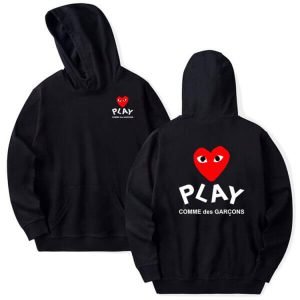Rei Kawakubo, the visionary designer behind the iconic fashion brand Comme des Garçons, is one of the most influential figures in the fashion industry. Her work has not only redefined the boundaries of fashion design but has also challenged conventional aesthetics, introducing Comme Des Garcons innovative concepts that still resonate in the fashion world today. Kawakubo’s influence on modern fashion is profound and widespread, shaping the way designers think about structure, silhouette, and the very notion of beauty. Through Comme des Garçons, she has created a legacy of experimentation, pushing boundaries, and defying norms, making her one of the most revolutionary designers of the 20th and 21st centuries.
A New Era of Fashion
Kawakubo founded Comme des Garçons in 1969, but it was in the early 1980s that the brand began to make waves internationally. When Comme des Garçons presented its collections in Paris in 1981, it marked the arrival of a new wave of Japanese designers. Kawakubo, along with other Japanese designers such as Issey Miyake and Yohji Yamamoto, introduced a radically different approach to fashion that was completely foreign to the French fashion establishment at the time. This marked the beginning of what is often referred to as the “Japanese Revolution” in fashion. Kawakubo’s designs were characterized by their deconstructed, asymmetrical shapes, and an emphasis on texture and fabric manipulation over traditional tailoring and fit.
At the heart of Kawakubo’s vision was the idea of rejecting the conventional notion of beauty in favor of something raw and unfinished. She embraced the concept of “anti-fashion,” creating garments that did not adhere to the typical standards of femininity or beauty. Instead of creating clothes to make people look “beautiful” in the conventional sense, Kawakubo sought to create garments that made a statement, ones that would challenge the viewer to reconsider their perceptions of what fashion could be. This rebellious attitude toward design set her apart from other designers of her time and paved the way for the experimental fashion that followed.
Breaking Down Boundaries
Kawakubo’s designs are known for their ability to break down the traditional boundaries between fashion, art, and culture. One of the key aspects of her work is the way she challenges the idea of clothing as a means of adornment. In many of her collections, she has deliberately chosen to eliminate traditional notions of “fit” and “flattery.” Her garments often appear unfinished, raw, and unrefined, with visible seams, rough edges, and asymmetrical shapes. These design choices question the very function of clothing and prompt a deeper reflection on its role in society.
For example, in her Spring/Summer 1982 collection, Kawakubo sent models down the runway wearing black, ragged clothing that looked almost like torn rags. The pieces were deliberately unpolished, devoid of any sense of glamour. This collection was met with shock and confusion, but it ultimately marked a turning point in fashion. It was a moment when fashion ceased to be about conformity and instead became a platform for self-expression and innovation. Kawakubo’s ability to manipulate fabric and create unconventional shapes opened up new possibilities for designers to experiment with their own designs.
Challenging Gender Norms
Another major way in which Kawakubo influenced modern fashion is through her challenge of gender norms. Much of her work subverts traditional ideas of gendered clothing. She has created collections that blur the lines between menswear and womenswear, with androgynous designs that question the very concept of gendered fashion. By rejecting the traditional feminine silhouette and embracing oversized, boxy shapes, Kawakubo has created a space for fashion that is not defined by gender.
Kawakubo’s work has been instrumental in deconstructing traditional gender roles, creating designs that are fluid and open to interpretation. This has had a lasting impact on the fashion industry, inspiring other designers to explore androgynous and unisex clothing. Designers like Haider Ackermann, Raf Simons, and Ann Demeulemeester have all drawn from Kawakubo’s groundbreaking approach to gender-neutral fashion, helping to further normalize the idea of fashion as a genderless form of expression.
Cultural and Artistic Inspirations
Kawakubo’s influence extends beyond the realm of fashion and into art and culture. She has consistently drawn inspiration from a wide array of sources, including philosophy, art, history, and even Japanese culture. One of her most famous collections, the “Lumps and Bumps” collection from 1997, explored the relationship between the body and Comme Des Garcons Converse clothing. The garments were designed with exaggerated, sculptural shapes that distorted the natural form, playing with the viewer’s perceptions of the human body. This collection, like many of her others, pushed the boundaries of what fashion could represent, blending fashion with art and questioning societal ideals of beauty and form.
Kawakubo’s approach to fashion design has also been deeply influenced by her interest in Japanese culture, particularly the concept of “wabi-sabi,” which emphasizes imperfection and the beauty of things that are imperfect, transient, and incomplete. This philosophy can be seen in the unfinished, raw aesthetic of many of her collections, where the process of creation is just as important as the final product.
The Legacy of Rei Kawakubo
Rei Kawakubo’s influence on modern fashion is undeniable. Through Comme des Garçons, she has redefined the way we think about clothing, beauty, and identity. Her work has inspired countless designers and has shaped the direction of contemporary fashion. She continues to challenge the status quo, introducing new ideas and aesthetics that keep the fashion world on its toes. As a designer, Kawakubo has shown that fashion is not just about clothing; it is a form of expression, an art, and a way to challenge and redefine the world around us. Her legacy is one of constant innovation, and her impact on modern fashion will undoubtedly continue for years to come.






Leave a Reply